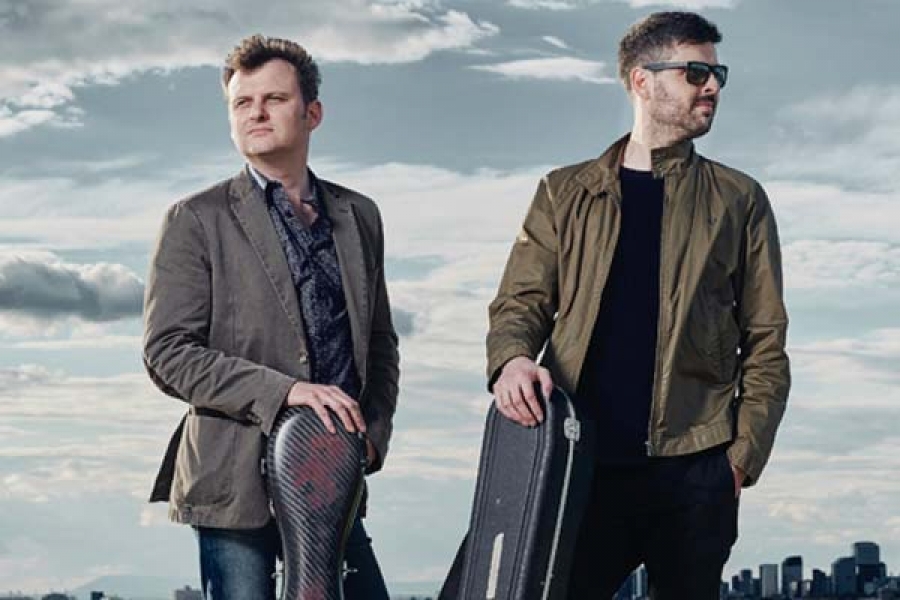- About Us
- Columns
- Letters
- Cartoons
- The Udder Limits
- Archives
- Ezy Reading Archive
- 2024 Cud Archives
- 2023 Cud Archives
- 2022 Cud Archives
- 2021 Cud Archives
- 2020 Cud Archives
- 2015-2019
- 2010-2014
- 2004-2009
 |
The Cud Review: |
Grigoryan Brothers This Is Us: A Musical Reflection of Australia
The National Museum of Australia situated in Canberra is a relatively new cultural institution. In 2021 it is celebrating its 20th birthday. It is possible that its relative youthfulness enables it to embrace a more modern philosophy than other museums which have old world antecedents. As part of the celebrations, the museum commissioned two outstanding musicians to record their original impressions of some key artefacts in the collection.
Guitarists Slava and Leonard Grigoryan chose 18 items from the museum which they found particularly moving and significant to Australian identity and composed pieces to express their reactions to each. The Grigoryans are very well placed to provide a contemporary interpretation of ‘Us’. Like many Australians, they have rich cultural backgrounds and a heritage extending beyond this island continent. They have direct personal experience of migration and the challenges of settling in a new land.
Both the Grigoryans and the museum have a keen understanding of the longevity of Australian culture and several of the chosen artefacts remind the listener that Indigenous society is the oldest anywhere. As we started to realise after the devastating bushfires of ‘black summer’ we ignore Indigenous knowledge at our peril. Indigenous presence is well represented with ‘Deep Time’ (haematite ochre from the Majedbebe rock shelter), ‘Journey Women’ (Papunya artwork),’Hunter’s Edge’ (a glass spear tip) and ‘Our Land’ (the tent embassy).
This CD – and the tunes available on the museum website – caught my eye initially because I have penned songs about several topics the Grigoryans found important. For example, they chose a ‘leaden heart’ from the museum’s collection of over 300. My song ‘A Convict Love Token’ celebrates a coin inscribed by my great-great-grandfather Charles Green for his wife Sarah in 1830 as he awaited transportation to Australia aboard the Eleanor for his part in the Swing riots which swept Hampshire and Berkshire. Swing rioters were named for their leader who styled himself Captain Swing.
They were rural Luddites who destroyed machines which threatened their livelihoods. Typically, the inscriptions were along the lines ‘when these words you see, I hope that you’ll remember me, until I gain my liberty’. There is a similarity about the messages, suggesting that some copying may have occurred among people with limited literacy skills. Sadly, neither Charles nor any of the 130 men aboard the Eleanor reunited with partners, although technically they were entitled to do so after their sentences of seven years expired.
The Grigoryans composed pieces for everyday objects such as the gate of Indigenous boys’ institution ‘Kinchela’, asylum seekers (Tampa life preserver), refugees (Minh Tam Nguyen’s Dan Tre musical instrument), immigrants (the fruit collecting apron-bag used by a migrant from Sicily) and sporting icons (Bradman’s bat and a locket with Les Darcy’s picture and a lock of his hair). Fred Hollows’ eye testing kit is there too with the first Holden, a Thylacine and Matthew Flinders’ anchor.
The sleeve notes contain descriptions of the artefacts, why the Grigoryans chose them and explanations of the music which emerged from their collaboration. Mostly there are two classical guitars in dialogue, but some pieces emerged from use of ukulele and electric and 12-string guitars as well. Whatever the process used however, the wonderful understanding between these brothers creates some superb listening. The CD of over 70 minutes beautiful guitar music is released on ABC Classic.
© 2021 Tony Smith
Dr Tony Smith is a former academic who now spends time busking and writing songs and reviews. He lives in the bush in the NSW Central West.
